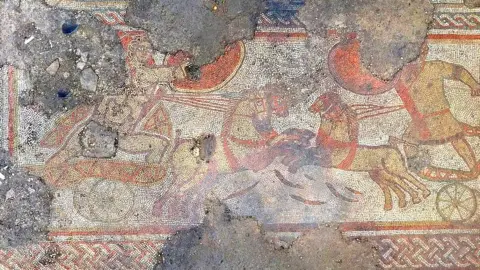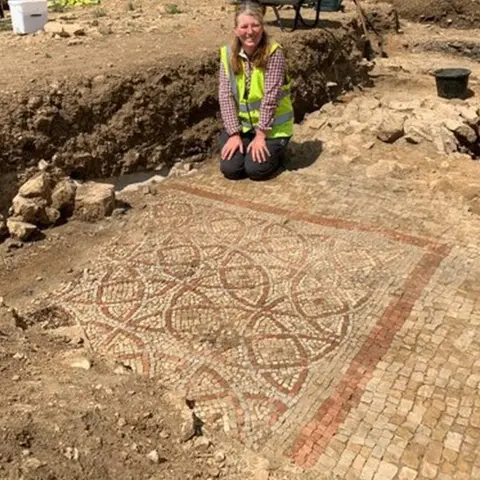Rutland Roman villa: More finds discovered beneath farmer's field
A "treasure trove" of finds has been unearthed at the site of a Roman villa discovered beneath a farmer's field.
Archaeologists said they were "gobsmacked" to find more lavish buildings and another mosaic when they returned to the area in Rutland.
Experts first found the artwork, which depicts scenes from Trojan war epic The Iliad, in a dig in 2021.
Historic England hailed it as one of the most significant of its kind in Britain.
The property included a large hall, about 50m (164ft) away from the villa, featuring a bath suite with hot and cold rooms as well as extensive living spaces. It was thought to have been occupied in the late Roman period, between the 3rd and 4th Century AD.
Experts believe the villa owners' extended family may have lived in the hall, which Historic England has likened to a 4th or 5th century barn conversion.
It was during the first national lockdown in 2020 when Jim Irvine first spotted some old pottery in one of his father's fields.
An archaeology enthusiast, Mr Irvine and his family started to dig and quickly realised they had found something spectacular.
 Historic England
Historic EnglandThe local archaeological finds officer was informed, along with Historic England, which led to experts from the University of Leicester being brought in to carry out more detailed excavations and surveys.
They returned in the summer and uncovered more buildings - a large hall, about 50m (164 ft) away from the villa, including a bath suite with hot and cold rooms as well as extensive living spaces, likely adapted from an earlier farm building.
The second mosaic is believed to be part of a dining or entertaining area of the large villa. It features an intricate geometric pattern and further supports the theory the villa was occupied by a wealthy individual, the organisation added.
John Thomas, deputy director of the university's archaeological services, said: "The (Lliad) mosaic is a fantastic eye-catching find, but it's just one element of a much bigger settlement that we now know of from the geophysics.
"The survival is just fantastic, it's a complete one-off really."

It also showed the estate was older than previously thought, possibly by a hundred years or more, meaning it was first occupied in the 2nd or 3rd Centuries CE.
Jennifer Browning, a projects officer with the University of Leicester archaeological services, said: "It's amazing; it sort of makes up for all the muddy ditches that I've spent a lot of my time in.
"Being able to work on something like this, it brings you a lot closer to the people that were living here".
Research on the artefacts recovered from the villa complex will continue in the years to come, but there are no plans for further excavations.
Its exact location in the county is being kept secret and it has now been covered back up to preserve it.
